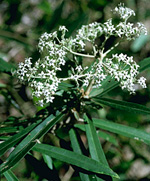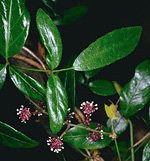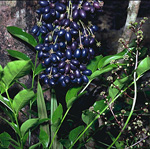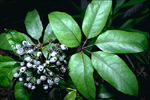 |
This widespread family is almost cosmopolitan, from temperate to tropical regions of all continents, but is absent from very dry and very cold areas. Most species in Australia occur in rain forests of the east and north. Astrotricha is unusual for the family, being found mainly in sclerophyll forests in southern Queensland, New South Wales, Victoria and the Pilbara district of Western Australia. The ivy Hedera sometimes escapes from gardens in the temperate States, where it may become a serious weed of disturbed forest adjacent to suburbs.
Characteristic features of the family Araliaceae in Australia include:
- trees or shrubs, with leaves usually palmately or pinnately divided
(simple in Astrotricha), and almost always entire, often with
stellate hairs
- stipules often large and fused with the petiole, which is often swollen and more or less sheaths the stem
- inflorescences basically umbellate (though often with the unit umbels arranged in panicles)
- flowers small, 5-partite, with early deciduous petals and a prominent disc
- inferior ovary of two fused carpels, forming a fleshy berry or two dry mericarps
Description
Evergreen trees, shrubs, or woody or herbaceous vines climbing by twining stems or by root suckers, rarely epiphytes or perennial terrestrial herbs perennating by taproots. Vegetative reproduction by rhizomes or otherwise uncertain. Internal secretions not obvious or of resin. Plants glabrous or with simple, dendritic or stellate, non-glandular, ?uniseriate or multiseriate hairs. Leaves alternate and spiral, or rarely in whorls or pseudo-whorls, all or mostly basal if herbs, petiolate, subsessile, or sessile, or rarely peltate. Stipules absent, or present and scale-like or membranous, fused to the petiole base, persistent; stipellae rarely present. Lamina simple, once compound, bicompound or tricompound, ternate, palmate or imparipinnate, symmetric or rarely conspicuously asymmetric, pinnatifid or pinnatisect, or palmatifid or palmatisect; lamina/leaflets filiform, acicular, subulate, linear, lanceolate, ovate, elliptic, oblanceolate, obovate or oblong; base cuneate, attenuate, rounded, cordate or oblique; margins entire or serrate, ±flat, revolute or recurved; venation pinnate, or palmate, with the midrib conspicuous, and the tertiary venation reticulate or not; surfaces not punctate; herbaceous or leathery; distinctive odour absent or aromatic. All the flowers bisexual, or with bisexual flowers and male flowers or with male and female flowers occurring on the same plant. Inflorescences terminal, cauliflorous or rarely ramiflorous, consisting of glomerules, racemes, panicles or umbels. Bracts present. Bracteoles present or absent. Pollination by insects. Flowers odourless, rarely fragrant or malodorous; sessile or stalked. Floral disc present; nectaries present on the disc. Perianth regular, or rarely the corolla irregular, of 2 dissimilar whorls. Calyptra rarely present. Calyx segments fused, with 5 lobes, open in bud; calyx cup-shaped; herbaceous. Corolla segments free or fused, with 5 or 7–12 (–18) petals or lobes, alternating with the calyx lobes, imbricate or valvate in bud; corolla wheel-shaped, white, cream, red, pink, magenta, purple, violet or green, without contrasting markings, membranous; claws rarely present; lobes ±entire. Fertile stamens 5, 7–numerous, opposite to the calyx lobes, free of the corolla, free of the ovary and style, distinct from each other, all ±equal. Anthers dorsifixed, versatile or not versatile, opening inwards by longitudinal slits; 4-celled. Ovary inferior. Carpels 2–5, fused; ovary with 2–4 locules. Style terminal, single and unbranched, or branched above or from the base. Ovules 1 (–2) per locule, stalked; placentation apical or axile. Fruit dry or fleshy; an indehiscent berry or drupe; or a schizocarp forming mericarps; the perianth on the maturing fruit deciduous or dry and persistent. Disseminule macro-surface featureless, or with stellate hairs, or costate, rarely winged; micro-surface ±smooth, white, cream, red, magenta, purple, violet, brown or black, glossy. Seeds 1–2 or 4–5 per fruit. Aril absent. Cotyledons 2. Embryo straight.
(Note: this description has been generated from the coded data compiled for the key. Any errors in the key data will be reflected in the descriptions.)
A treatment of the family Araliaceae has not yet been published in the Flora of Australia. It will appear in Volume 27.
Australian genera of Araliaceae (as recognised for the Flora of Australia)
* = all species introduced
Aralia
Astrotricha
Cephalaralia
Delarbrea
*Fatsia
*Hedera
Mackinlaya
Motherwellia
Polyscias
Pseudopanax
Schefflera
*Tetrapanax

|
  |

Astrotricha sp. Nadgee (flowers)
Photo: M.Fagg © ANBG

Cephalaralia cephalobotrys (flowers)
Photo: M.Fagg © M.Fagg

Delarbrea michieana (flowers and fruit)
Photo: H.Nicholson © H. & N. Nicholson

Mackinlaya macrosciadia (fruits)
Photo: H.Nicholson © H. & N. Nicholson

|
 |
|